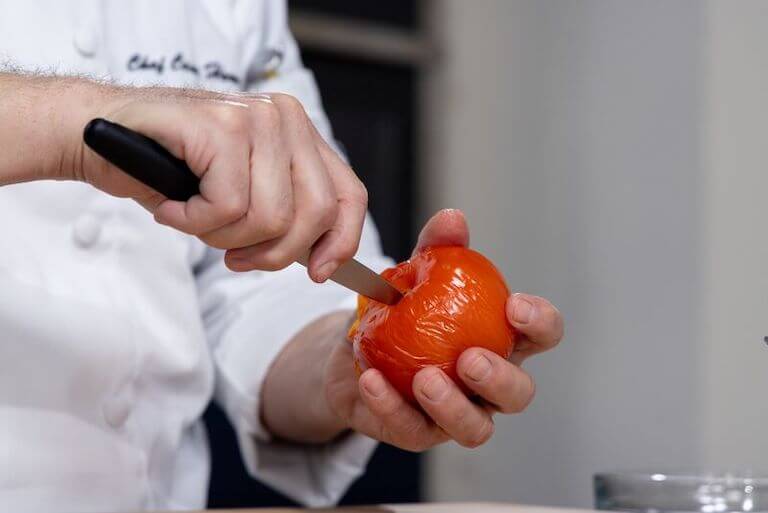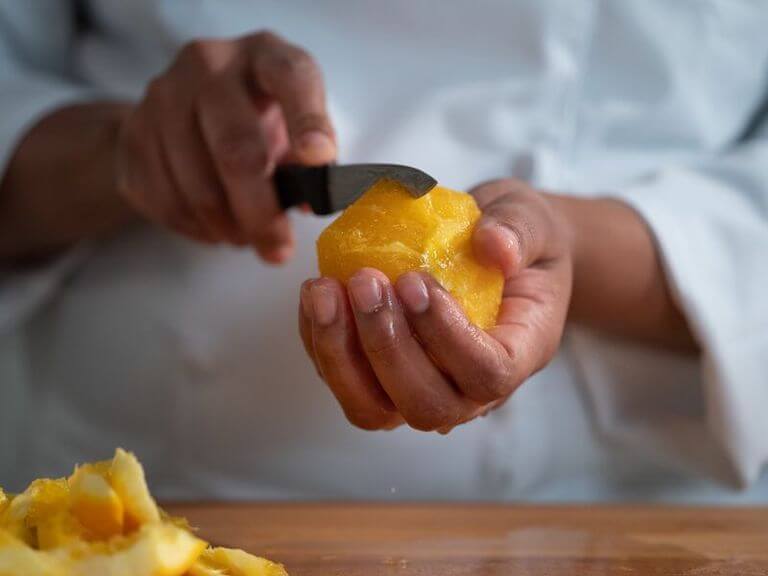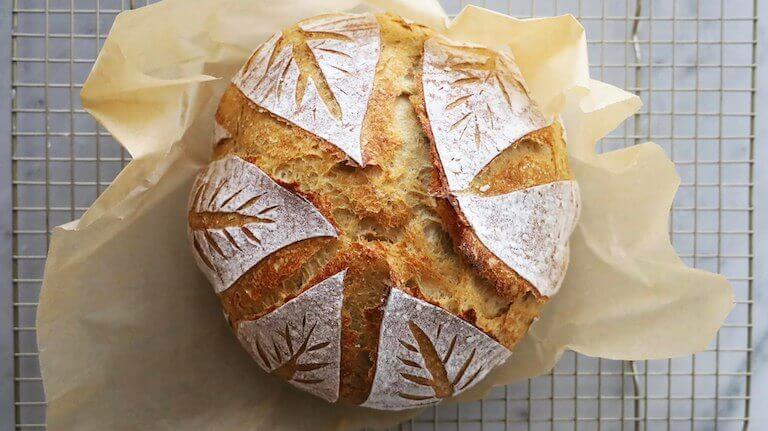Listen to This Article:
We talk a lot about the chef’s knife, and for good reason—it’s the most frequently used knife, it’s versatile, and it’s good-looking. Many chefs have a favorite that’s been by their side for decades.
But there’s another tool that deserves some recognition: the paring knife. Admittedly less flashy, the paring knife is a workhorse and a must-have in the kitchen. In fact, if you only had three knives to use, this would be one (chef’s knife and a serrated knife being the other two).
Wondering what makes it so special? Read on to find out more.
What Is a Paring Knife? Its Design and Uses
A paring knife is essentially a mini chef’s knife with a small, slightly curved blade that offers great versatility and precision. While the blade on a chef’s knife ranges from six to 14 inches, the paring knife is short—usually no longer than 3.5 inches.
This tool might conjure images of grandma peeling apples or old-timey cartoons featuring enlisted men on kitchen patrol (KP) peeling a mountain of potatoes during basic training, but its versatility has stood the test of time.
Same as a chef’s knife, you have choices in material, like carbon steel vs stainless steel, and a choice of handles. They also come in a range of price points.
The knife’s origins are difficult to pinpoint, but there’s no denying it’s iconic—it’s such a staple that the paring knife shows up in a collection in the National Museum of American History in the museum’s Home and Community Life: Domestic Life exhibition.
Why Is It Called a Paring Knife?
Unlike a steak knife or a chef’s knife, the paring knife’s name is a little less obvious. It gets its name from the word “pare,” meaning to peel away or cut away the outer surface.
French bookbinders used a tool called a paring knife to thin the edges of leather book bindings; the blades of those were longer and fatter than today’s kitchen knife, which is believed to have descended from the book-binding tool.
A Paring Knife is The Kitchen’s Utility Player
Though it’s often associated with peeling, the paring knife has a number of other uses. It’s great for mincing small amounts of garlic and onions or coring tomatoes, and it’s useful when working with small or tender vegetables and fruit like ginger, strawberries, garlic, and shallots.
It can devein shrimp or scrape the seeds out of peppers, and it’s also good for detail work like creating garnishes.
When to Reach for Another Tool
The paring knife isn’t suited for harder vegetables like carrots, beets, or squash, so proceed with caution on those. You don’t want to use too much force, so if you feel like you’re starting to add too much muscle into the mix, consider going to a heavier blade, like a utility knife.
The blade of a utility knife is longer than a paring knife and narrower than a chef’s knife, usually around six inches long. It offers the heft of a chef’s knife and some of the precision of the paring knife.

The small size and sharp tip of a paring knife make it ideal for deseeding.
Paring Knife Safety Tips: It’s Little, But It Can Hurt You
Don’t be fooled by the paring knife’s diminutive size—like any sharp object, you should proceed with caution.
Safety begins with understanding the best uses for your knife. Remember the types of food it works well with, and when you should consider switching to another tool. Like any knife, you want it to feel balanced in your hand; a better feel can give you a more secure grip.
Here are some other tips:
- Keep it sharp so your paring knife can cut more easily, with less force required.
- When washing and drying, point the blade away from you.
- As you guide food toward the knife, curl your fingers inward, i.e. the hand holding food should look a little like a claw whenever possible.
- Use a stable cutting board. You can put a non-slip mat underneath to help.
- Store knives in a manner that will help prevent you from grabbing a blade. This can include a wall-mounted magnetic strip, a knife block, edge guards, and drawer inserts.
6 Ways to Use A Paring Knife
The paring knife is a versatile tool with tons of uses. Here are some of the most common:
1. Peeling
Use your paring knife to remove the skins from apples, potatoes, kiwis, mangoes, maybe even tomatoes.
Technique: A paring knife is the one knife with which you’ll peel towards your body rather than away from it (away being the golden rule for most slicing and chopping). Hold the fruit or vegetable in your non-dominant hand and grip the paring knife in your dominant hand, with your fingers wrapped firmly around the handle. Peel towards yourself and use your thumb to guide the item, being careful not to cut yourself. Rotate the item as needed, like when peeling an apple.
2. Coring, Pitting, Deseeding
The control you have with a paring knife makes it ideal for coring, pitting, and deseeding. Think cherry pits, the hulls of strawberries, or the seeds in peppers.
Technique: The sharp tip of the knife comes in handy for these jobs. You can use the tip of the knife to make a cone at the top of a strawberry and cut off the leaves as well as part of the tough flesh. Or you can simply slice straight across the top using a similar grip as when peeling. When deseeding a pepper, use the paring knife to cut the ribs and scrape the seeds out after you’ve sliced it. You can deseed a lemon by inserting the tip of the knife under a seed and flicking the seed out.
3. Segmenting
Segmenting typically involves cutting wedges of fruit, like lime for a margarita or oranges for a salad.
Technique: Hold the fruit firmly in place on a cutting board, and use the knife to slice it in half lengthwise. Then slice each half in half again until you have wedges. Use the sharp tip of the paring knife to cut the white pith from the wedge, leaving the juiciest, tastiest part of the fruit.

A paring knife is good for peeling, coring, deveining, and other cuts in smaller items.
4. Deveining
The tip of the paring knife is good for deveining shrimp, which calls for a precise slice that gets at the vein—which is actually the shrimp’s intestine—while leaving the shrimp intact.
Technique: After you’ve removed the shrimp from its shell, use the tip of the knife to make a shallow slit that exposes the vein. Then use the knife to work the vein out, being careful not to slice it.
5. Scoring
The precision of a paring knife makes it useful for decorative scoring on breads. These cuts or slashes on the surface of bread dough help control the dough’s expansion, allowing steam to escape during baking and giving bakers a way to express creativity with the loaves. You might use a paring knife to score a pie crust to allow steam (and some juices) to escape. You can also use a paring knife to score meat; these shallow cuts can help marinades absorb better, can give the meat a crispier edge, and can tenderize it.
Technique: For bread, scoring is done after the final proofing and typically includes a combination of slashes to create patterns and control the way the bread expands when baked. For meat, you can cut through layers of fat or make shallow slashes across the top, depending on your needs.

Leaf scoring can be performed with a paring knife. This loaf created by Escoffier Online Baking & Pastry Arts Graduate, Danny N.
6. Detailed Cuts
A paring knife in the right hands can be like a paintbrush in the hands of an artist. You can make a rose out of a tomato peel, cut fruits into the shapes of flowers, and slice garnishes into impressive shapes for your favorite mocktails.
Be Nice to Your Paring Knife—Proper Care and Maintenance
Proper care of your knives begins by using them properly. You want to avoid cutting frozen foods with most knives, for example, and remember to use the spine, or backside, of the blade if you’re scraping food off of a cutting board with your knife. Wooden and plastic cutting boards tend to be better than marble or glass, which can dull your knives.
As with any knife, you should hand wash your paring knife and then dry it immediately. This includes the handle, where bacteria can grow.
You can manually sharpen your paring knife with a whetstone, or sharpening stone, or you can use an electric sharpener. Sharpen it once or twice a year, depending on how much you use it. You should also hone your knife before each use; honing is a process that keeps the blade straight by aligning the edge, which can bend and warp.
Explore Knife Skills and More
A paring knife is a classic chef’s tool that can be used for basic prep tasks or more advanced uses. The more you practice, the more you’ll find what works best for you.
Most Escoffier culinary arts degree and diploma students start their programs by exploring and practicing their knife skills before moving on to other techniques. If you’re interested in discovering more about how culinary school can help you become familiar with new tools and techniques, contact us today.

